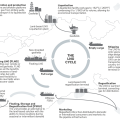Unlock the Editor’s Digest for free
Roula Khalaf, Editor of the FT, selects her favourite stories in this weekly newsletter.
Despite the energy industry’s gloom about Labour’s plans to bring in higher taxes and block new developments in the North Sea, investors are far more optimistic. Serica Energy, one of the hardest hit by the windfall tax, was in the top-10 additions to Fidelity Isas in June, alongside BP.
Serica itself has warned of the impact of the government’s plan to reduce tax relief for capital expenditure, which will “rapidly and terminally accelerate the decline in UK oil and gas production”, in the words of chair David Latin. But it’s not just retail shareholders who are optimistic.
“We see the market as more than discounting the impact of windfall taxes, with c.95 per cent of the current market cap generated in free cash flow across 2024-26 at our $70-a-barrel oil price forecast,” said Stifel analyst Chris Wheaton, not an advocate for Labour’s North Sea policies.
On an operational basis, 2024 has been good for Serica so far. Production guidance has recently been reiterated at around 43,500 barrels of oil equivalent per day after successful well campaigns at the Bruce and Guillemot fields. The company also has net cash of £121mn, providing “significant firepower” for M&A alongside its free cash flow generation, said Investec analyst Alex Smith.
A new government is not the only change Serica is dealing with. Chief executive Chris Cox started this month, replacing Mitch Flegg. Cox, formerly the boss of Centrica subsidiary Spirit Energy, has quickly joined the ranks of shareholders. In his first week in the job, the chief executive bought 390mn shares in the company, in one purchase worth £426,000 and another worth £170,000. He now holds 0.11 per cent of Serica shares. The company declined to comment on the purchases.
Directors trade at Raspberry Pi
In the last two years, the world has become obsessed with Nvidia’s highly expensive graphics processing units. However, most computing tasks don’t require this level of sophistication.
Newly listed Raspberry Pi started building cheap and robust credit card-sized computers for hobbyists and educational purposes. It has since branched out into the industrial space, which now makes up 72 per cent of revenue. The robust nature of its chips makes them suitable for electric vehicle charging, lifts and escalators, as well as sports performance-tracking and digital signage.
The remaining 28 per cent of revenue still comes from education. The advantage of this is that Raspberry Pi has its own operating system. This is open source and free to owners of the company’s computers. So, if a student learns computing through Raspberry Pi, they could then decide to use it in their professional life as they are familiar with the product.
In 2023, the company made $266mn (£207mn) in revenue, almost double the $141mn it generated in 2021. Correspondingly, its profit before tax has more than doubled to $38mn. However, this is overstating its profitability because it capitalises most of its R&D spending.
Raspberry Pi’s share price is up 51 per cent since it listed last month. In the last week, chief commercial officer Mike Buffham decided to cash in on some of this price increase, selling £709,000 worth of shares. Meanwhile, non-executive director Daniel Labbad spent £97,000 buying shares in June.
A degree of comfort should come from the fact the UK’s most successful semiconductor company, Arm, remains the largest shareholder behind the Raspberry Pi foundation. Raspberry Pi might have a rich valuation relative to its non-existent cash flow but on a revenue basis it doesn’t look too expensive, and growth is impressive. The London Stock Exchange isn’t used to tech companies but so far investors seem to have taken a liking to this one.


